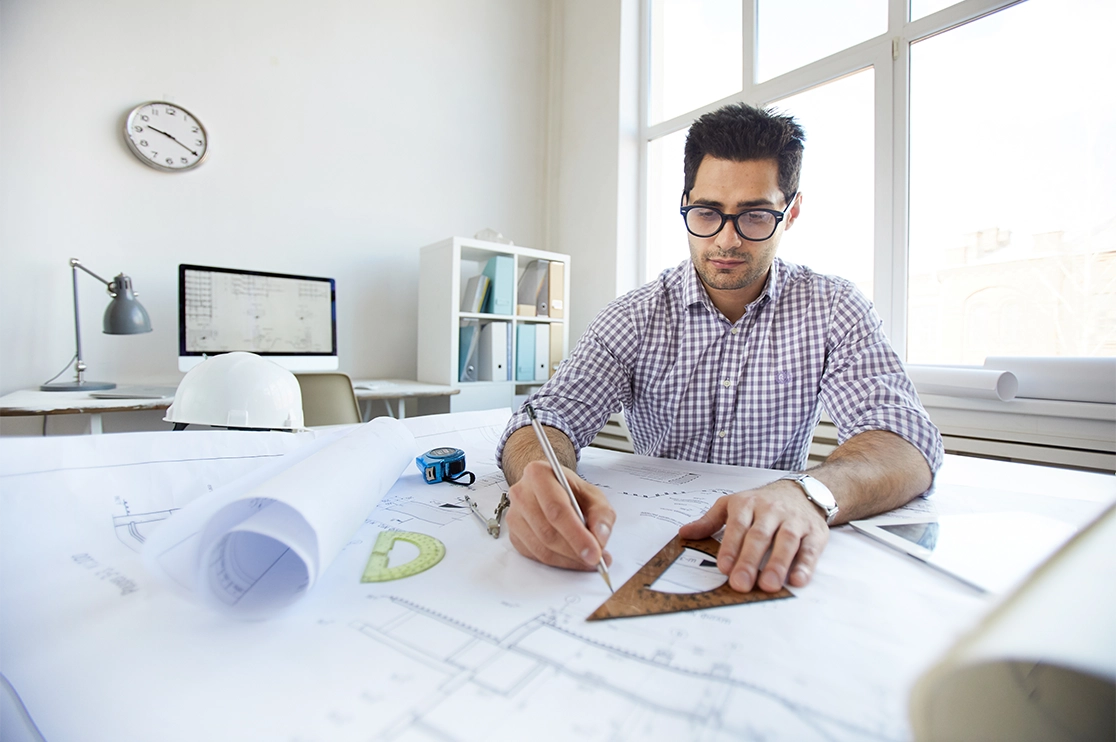Architect Guide to Sustainable Building Materials
Architect Guide to Sustainable Building Materials
Blog Article
Understanding the Diverse Profession Paths Available for Aspiring Architect
As an ambitious Architect, you have a world of occupation paths waiting on you. Each course offers one-of-a-kind challenges and chances to use your creativity and technical expertise. Whether you're drawn to traditional architecture or the subtleties of sustainable style, there's a specific niche that straightens with your interests. Comprehending these varied alternatives can shape your expert trip, but which direction will you pick to explore initially?
Conventional Architecture: Designing Structures and Frameworks
Conventional architecture concentrates on developing structures and frameworks that blend functionality with visual allure. As you discover this field, you'll value the elaborate balance between kind and function. You'll learn to attract ideas from historic designs, including elements like balance, products, and craftsmanship. Your designs can show social heritage, showcasing local customs while satisfying modern-day needs.
You'll establish abilities in preparing, model-making, and website evaluation, allowing you to envision and connect your concepts successfully. Engaging with customers, you'll need to comprehend their vision and translate it right into possible layouts.
Additionally, developing codes and sustainability methods are essential in your job, ensuring your frameworks are ecologically friendly and secure. As you grow in your career, you'll discover chances in domestic, commercial, or perhaps restoration projects, each offering special difficulties. Welcoming standard design paves the means for a meeting profession that pays homage to the past while forming the future.
Urban Planning: Forming Communities and Public Spaces
As an aspiring Architect, you can play a vital role as an urban organizer, transforming exactly how neighborhoods interact and operate. By using area engagement strategies, you'll guarantee that locals have a voice in forming their setting. And also, incorporating lasting style concepts will aid create spaces that not just satisfy today's needs however also shield the future.
Role of Urban Planners
While lots of may think of engineers as the sole enthusiasts behind structures, city organizers play a necessary duty in forming the broader landscape of neighborhoods and public rooms. By working together with numerous stakeholders, you'll aid create parks, transport systems, and domestic locations that promote social communication and availability. Your competence in spatial layout and neighborhood characteristics allows you to envision future development while maintaining cultural heritage.
Area Involvement Techniques
Effective neighborhood involvement methods are vital for metropolitan planners to assure that the voices of locals are heard and valued in the planning process. To cultivate significant discussion, you ought to focus on open forums and workshops where area members can reveal their concepts and concerns. By actively incorporating and paying attention responses, you'll create rooms that mirror the area's requirements, eventually leading to more effective and lasting urban settings.
Sustainable Design Principles
When making metropolitan spaces, integrating sustainable design concepts is important for producing atmospheres that flourish both ecologically and socially. Consider integrating green areas, like parks and yards, to boost biodiversity and enhance air quality.
Designing with water conservation in mind is also key-- think of rain gardens and permeable surfaces to handle stormwater. Entailing neighborhood participants throughout the planning procedure warranties that the spaces you develop fulfill their demands and urge social interaction. By accepting these principles, you'll add to vibrant, sustainable metropolitan landscapes that profit every person.

Landscape Architecture: Producing Lasting Exterior Settings
As you check out landscape style, you'll find vital layout principles that produce lovely and useful exterior rooms. Sustainable practices play an essential duty in making sure these environments flourish while lessening environmental impact. Plus, you'll find a range of career possibilities that allow you to make an actual distinction in how individuals interact with nature.
Design Principles in Landscape
Recognizing design principles in landscape architecture is essential for developing lasting exterior atmospheres that integrate with nature. You'll need to consider elements like proportion, balance, and scale to assure your designs feel natural and inviting. Additionally, pay focus to seasonal changes, making with materials that match the surroundings year-round.
Sustainable Practices Overview
Sustainable methods in landscape style not only focus on aesthetic appeals but additionally prioritize ecological health and resource conservation. You can make areas that promote dirt health and wellness, such as exercising and making use of organic products permaculture principles. Inevitably, these techniques ensure your designs benefit both people and the atmosphere for years to come.
Occupation Opportunities Expedition
With a strong foundation in lasting techniques, landscape design uses a variety of occupation paths that permit you to make a purposeful effect on the atmosphere. Urban organizers often collaborate with landscape architects to develop environment-friendly spaces in city settings, boosting city livability. If you're enthusiastic concerning education, take into consideration ending up being a landscape style educator, motivating future generations.
Lasting Design: Concentrating On Eco-Friendly Practices
As you discover your career in style, welcoming green practices can establish you apart in an affordable area. Lasting navigate to this site layout focuses on creating buildings that decrease environmental effect while improving resident well-being. By integrating sustainable materials, energy-efficient systems, and sustainable building strategies, you'll add to a greener future.
Beginning by getting understanding of environment-friendly accreditations like LEED or BREEAM, which can reinforce your qualifications. Take into consideration exactly how natural light, air flow, and thermal effectiveness can maximize layout. Team up with engineers and ecological specialists to introduce options that decrease waste and preserve resources.
Don't fail to remember the value of neighborhood participation-- interesting regional stakeholders can influence layouts that balance with the setting. As customers significantly prioritize sustainability, your expertise in environmentally friendly methods will certainly not only bring in tasks but additionally satisfy your interest for liable style. Welcome this vital facet of the occupation, and see your job flourish.
Historic Preservation: Securing and Restoring Social Heritage
While you start on your building trip, consider the vital role of historical conservation in preserving our social heritage. This area focuses on website here the security and repair of significant structures, websites, and structures that inform the stories of our past. By participating in historic conservation, you'll aid safeguard the building heritage that shapes area identity.
As a historical conservation Architect, you'll analyze historical significance and examine the problem of frameworks. You'll work carefully with conservationists and historians to assure authentic reconstruction techniques are employed. This profession course enables you to blend creative thinking with research study, allowing you to make services that value initial materials and craftsmanship.
Your job not only adds to sustainability by reusing existing structures however likewise promotes a sense of pride within communities. Embracing this path will certainly aid you come to be a guardian of background, protecting the tales and appearances that enhance our lives.
Inside Architecture: Enhancing Indoor Spaces
Historic conservation and indoor style both share a dedication to enhancing the constructed atmosphere, but they focus on various facets. While historic conservation emphasizes keeping a structure's historic and social worth, interior architecture nos in on optimizing interior areas for capability and looks.
As an aspiring Architect, you'll discover that indoor design permits you to mix imagination with technical abilities. You'll develop spaces that not only look excellent however also promote convenience and effectiveness. This area entails recognizing exactly how light, shade, and products engage within a room, affecting state of mind and usability.
You'll deal with different tasks, from household homes to business offices, making sure that each setting meets the needs of its owners. By focusing on individual experience, you can change interiors right into functional and motivating spaces, making a substantial influence on just how individuals communicate with their surroundings. Accept the opportunity to boost interior environments and form the method individuals live and function.
Industrial Style: Merging Functionality With Aesthetics
Commercial layout plays a vital role in producing items that seamlessly blend aesthetic appeals with performance, making certain that what you make use of day-to-day is not just aesthetically enticing but also practical. As an aspiring Architect, you can immerse yourself in this field, focusing on making whatever from furnishings to consumer electronics. Your job involves understanding individual requirements, materials, and making processes, permitting you to produce innovative services that improve everyday experiences.
In commercial layout, you'll frequently work together with manufacturers, designers, and online marketers, ensuring that your layouts are not only lovely however likewise viable. You'll find out to stabilize kind and feature, focusing on functionality without giving have a peek at this site up style. By developing your skills in laying out, 3D modeling, and prototyping, you'll be well-equipped to bring your ideas to life. This profession path supplies a vibrant atmosphere where imagination fulfills practicality, making it a satisfying choice for architects curious about forming the items of tomorrow.
Often Asked Questions
What Educational Credentials Do I Required to End Up Being an Engineer?
To come to be an architect, you'll need a professional level in design, commonly a Bachelor's or Master's. Furthermore, you'll need to finish an internship and pass the Architect Enrollment Assessment to practice lawfully.
Are There Qualification Needs for Different Building Career Paths?
Yes, there're certification requirements for numerous architectural courses. Architect. You'll require to pass exams, complete internships, and in some cases go after specialized training, relying on your selected focus, like landscape design, metropolitan design, or historical conservation
What Software Application Abilities Are Vital for Architects Today?

Just How Can I Gain Practical Experience While Studying Architecture?
You can obtain practical experience by interning at architectural companies, joining design competitors, offering for area jobs, or teaming up with classmates on real-world projects. These chances improve your abilities and construct beneficial connections in the sector.
What Task Opportunities Exist Outdoors Standard Style Firms?
You can explore numerous work opportunities outside standard style companies, like urban planning, indoor style, landscape design, building management, property advancement, and even duties in sustainability consulting. Each deals unique difficulties and incentives.
Whether you're drawn to traditional style or the subtleties of lasting layout, there's a niche that straightens with your rate of interests.When developing city rooms, integrating sustainable style principles is essential for creating atmospheres that flourish both ecologically and socially.As you explore landscape design, you'll uncover vital design concepts that develop functional and stunning outdoor rooms.Understanding design concepts in landscape style is important for producing sustainable outdoor environments that balance with nature.In commercial layout, you'll usually work together with designers, marketing professionals, and makers, making certain that your styles are not just beautiful yet likewise practical.
Report this page